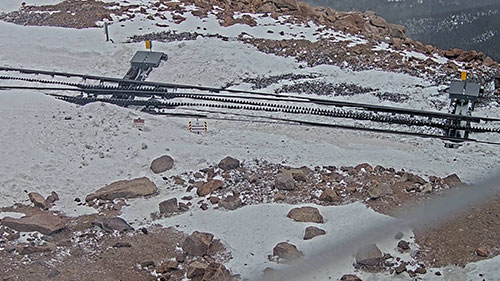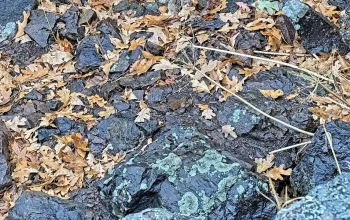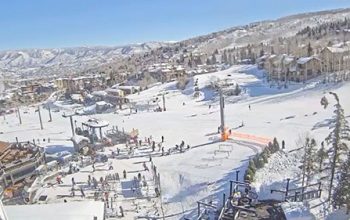Pikes Peak Webcams: Live Views from America’s Mountain
The Pikes Peak Cog Railway climbs steep slopes, passing through forests and rocky cliffs. Webcams along the route capture every moment as the train makes its way to the top. You can see the changing landscape in real time, from lush greenery to alpine tundra.
Experience Breathtaking Summit Views
At 14,115 feet, Pikes Peak offers some of the best views in Colorado. Live webcams at the summit show the vast Rocky Mountains, rolling plains, and distant cityscapes. On clear days, you can even spot Denver far away.
Enjoy a 360-Degree Perspective
Several webcams provide a full 360-degree view of the peak. Watch stunning sunrises, shifting clouds, and even sudden snowfalls. Whether planning a visit or just exploring from home, these cameras bring the mountain’s beauty to you.
Check out the Pikes Peak webcams and enjoy the view anytime!
The History of Pikes Peak
Indigenous Roots: The First Inhabitants
Long before explorers and settlers arrived, the Ute people lived in the shadow of Pikes Peak. They called it “Tava,” meaning Sun Mountain. The Utes believed the mountain was sacred and used its slopes for hunting and spiritual practices. Other indigenous people, including the Arapaho, Cheyenne, and Comanche, also passed through the region.
For centuries, the Ute people thrived in the area, following game and using natural hot springs for healing. However, as European explorers and settlers arrived, their way of life changed forever.
The First European Explorers
In November 1806, Zebulon Montgomery Pike, an early American explorer, spotted the massive peak. He called it “The Great Peak” and attempted to climb it. However, heavy snow forced his team to turn back at 10,000 feet. Although the mountain now bears his name, Pike never reached the summit.
In 1820, Edwin James, a botanist and naturalist, became the first recorded person to reach the top. His team collected plant specimens along the way, many of which were new to science. James Peak, located in Colorado, was later named in his honor.
Gold Rush and “Pikes Peak or Bust”
After the Louisiana Purchase, settlers moved westward in search of land and fortune. By the 1850s, the Pikes Peak Gold Rush brought thousands of prospectors to Colorado. The phrase “Pikes Peak or Bust” became their battle cry, symbolizing their determination to strike it rich.
During this time, Julia Archibald Holmes became the first recorded woman to summit the mountain in 1858. She hiked the rugged trails while wearing the controversial “bloomers,” an early form of women’s pants.
Early Weather Observations
In 1873, the U.S. Signal Service, a forerunner of the National Weather Service, built a telegraph station at the summit. Scientists used this high-altitude station to study weather patterns. The data helped improve forecasts and laid the groundwork for future meteorological research.
The Birth of the Cog Railway
By the 1880s, reaching Pikes Peak was a difficult journey. Most visitors either hiked or rode mules to the top. One visitor, Zalman Simmons, owner of the Simmons Mattress Company, experienced this firsthand.
After a long, exhausting ride to the summit, he relaxed in the hot springs of Manitou Springs. A local hotel owner suggested an idea: build a railway to the top. Simmons was intrigued. Soon after, he helped form the company that built the Manitou & Pikes Peak Cog Railway, which opened in 1891.
Pikes Peak Today
Today, Pikes Peak remains a symbol of adventure. The Cog Railway continues to carry visitors to the summit, offering breathtaking views of the Rockies and Great Plains. The mountain’s rich history, from its indigenous roots to modern tourism, makes it one of Colorado’s most treasured landmarks.
Whether hiking, driving, or taking the railway, every trip up “America’s Mountain” is a journey through history.
The Geography and Topography
A Towering Landmark in Colorado
Pikes Peak rises 14,115 feet above sea level, making it one of Colorado’s most famous Fourteeners. It stands in the Front Range of the Rocky Mountains, near Colorado Springs. Its massive size and distinct shape make it visible from miles away.
Rocky Terrain and Unique Features
The mountain consists mostly of Pikes Peak granite, a type of pinkish rock formed over 1 billion years ago. Weather and erosion have shaped its rugged cliffs, steep slopes, and deep valleys. At lower elevations, forests of pine, spruce, and aspen cover the land. As you climb higher, the trees thin out, giving way to alpine tundra. Near the summit, strong winds and freezing temperatures create a harsh, almost barren landscape.
Diverse Ecosystems
Pikes Peak has multiple climate zones, each with its own plants and animals. Wildlife such as marmots, bighorn sheep, and mountain lions live on its slopes. In the summer, colorful wildflowers bloom across the alpine meadows. However, in winter, heavy snowfall and icy winds make the mountain a challenging place to explore.
Panoramic Views from the Summit
At the top, the views stretch for hundreds of miles. On a clear day, you can see the Great Plains to the east and the Sawatch Range to the west. The famous Pikes Peak Highway and Cog Railway provide access to the summit, where visitors can take in the breathtaking scenery.
Pikes Peak’s diverse geography and dramatic topography make it one of the most awe-inspiring mountains in the United States.
The Climate and Average Precipitation of Pikes Peak
Harsh and Ever-Changing Weather
Pikes Peak has an alpine climate, meaning conditions can change quickly. Temperatures at the summit stay much colder than in nearby Colorado Springs. Even in summer, it rarely gets above 50°F (10°C). In winter, temperatures often drop below 0°F (-18°C) with wind chills making it feel even colder.
Snowfall and Precipitation
Pikes Peak receives a lot of snow, especially in the winter and spring. The summit gets an average of 200 inches (16.6 feet) of snow per year. Snow can fall even in summer, though it usually melts quickly.
Rainfall varies by elevation. Lower areas get about 20 inches per year, while the summit sees closer to 25 inches. Thunderstorms are common in the summer, bringing sudden rain, lightning, and even hail.
Strong Winds and Thin Air
The peak experiences extreme winds year-round. Gusts often exceed 75 mph, and storms can push winds past 100 mph. This creates dangerous conditions, especially for hikers.
The air is also much thinner at 14,115 feet. Oxygen levels drop by about 40%, making breathing difficult for some visitors.
A Mountain of Weather Surprises
Pikes Peak’s unpredictable climate adds to its challenge and beauty. Whether covered in snow or bathed in sunshine, the mountain always offers something unique. Anyone visiting should prepare for anything, no matter the season!



